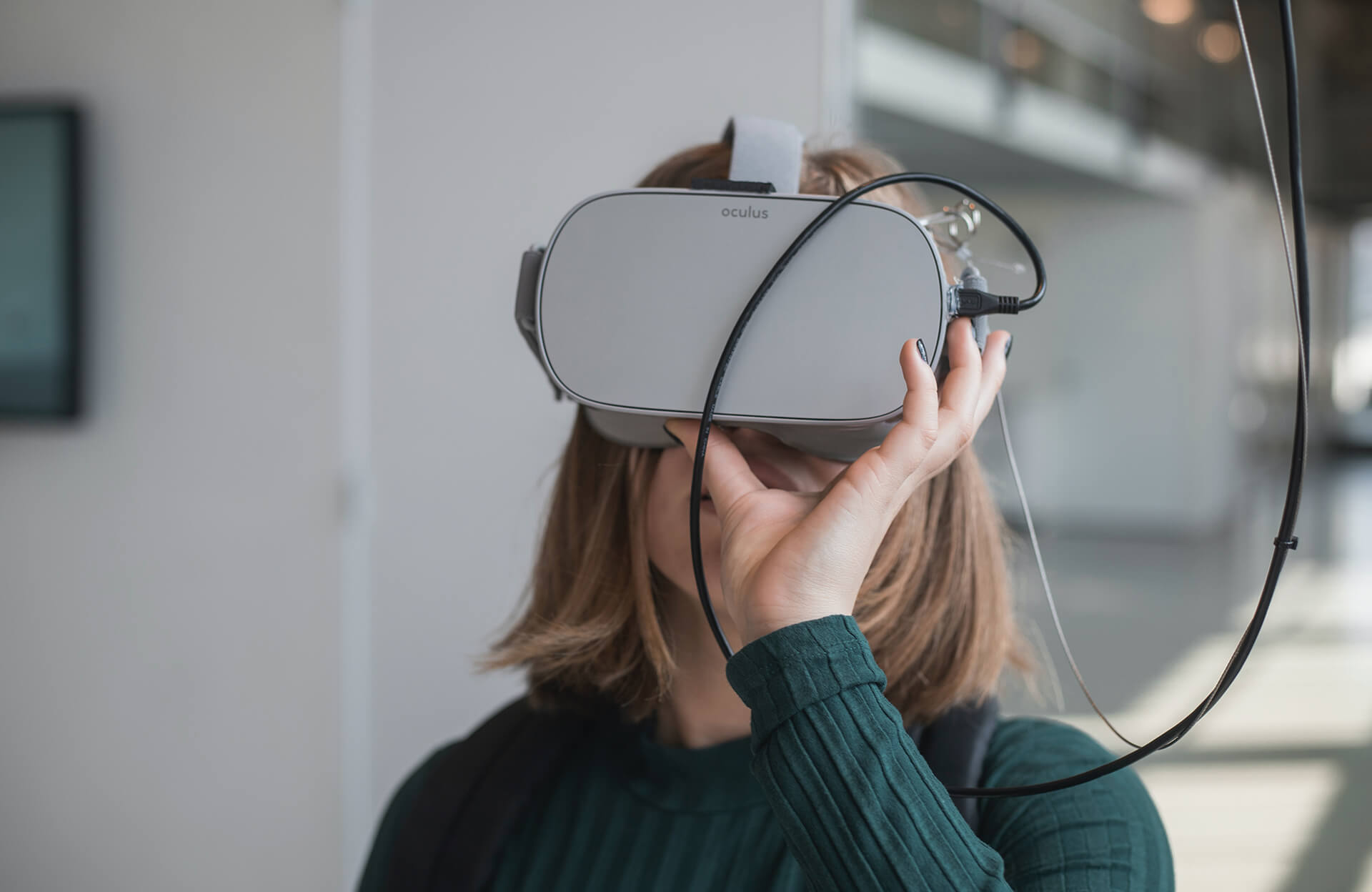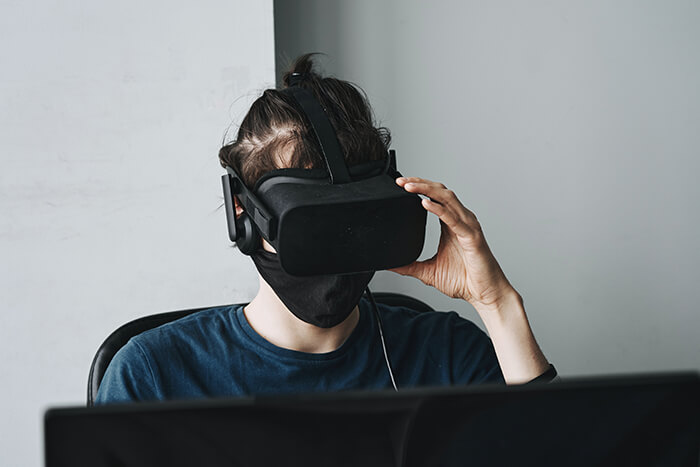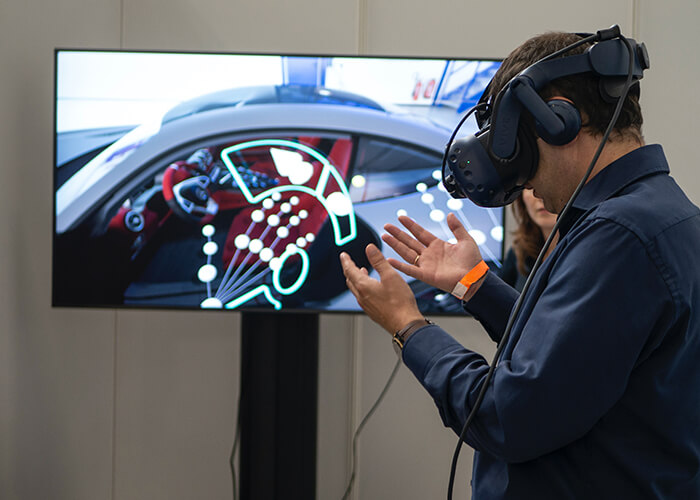Thank You!
A confirmation latter has been sent to your email. Check your inbox.


As it is said, ‘innovation is the calling card of the future’; the digital world has already rolled up its sleeves to step into a new era of technological innovations furnishing endless possibilities with the help of AR and VR technology, transforming how we interact with the world and creating new opportunities for industries across the globe. Augmented Reality (AR) and Virtual Reality (VR) have emerged as portals to a parallel dimension of possibilities. Where AR artfully blends our physical reality with digital overlays, enriching our surroundings with captivating information and interactive experiences, conversely, VR takes us on a thrilling journey to entirely new realms, transporting our senses beyond the confines of the real world.
From education to healthcare, entertainment to manufacturing, AR and VR are revolutionizing the way we work, learn, and play. AR is influencing businesses to create immersive experiences for their customers, allowing them to explore products and services in a whole new way; VR is being used to train employees in high-risk jobs, giving them a safe and controlled environment to practice their skills. Therefore, the impact of AR and VR technology on industries across the globe is already significant, and it is predicted to continue to grow in the coming years.
According to a report by MarketsandMarkets, the global AR and VR market size is expected to reach approx $571.4 billion by 2025, at a CAGR of 105.2% during the forecast period. Further, the demand for AR and VR technology has been prominently hyped up for good in gaming, education, healthcare, and retail sectors, building new realities in every industry with their transformative powers to turn fiction into factuality and becoming a ‘game changer’ for them.
AR and VR are redefining the meaning and methods of eCommerce and the shopping experiences of people around the globe. These technologies are being applied to virtual stores where customers can browse and purchase products without leaving their homes. Retailers can use AR to provide customers with a virtual try-on experience, allowing them to see how products look on them before buying and allowing consumers to interact with products in whole new and exciting ways.
AR apps are already thriving, generating these experiences for real, and a prime example is the furniture and appliance retailer IKEA, which allows users to digitally visualise furniture in their homes using the IKEA Place app on a mobile device. Also, companies like Lenskart provide virtual try-on facilities for customers on a ‘try before you buy’ basis.
Google Maps’ AR Navigation and Apple’s ARKit 5 are potential examples of this use case where AR is used to make navigation more convenient for users. Capabilities like pathfinding indicators, motions of tacking, and expanded support for location anchors are upskilling the navigation applications to new heights.
Physicians and caregivers in the healthcare industry have immensely proliferated and empowered through the advent of advanced technology and tools, including AR and VR. Moreover, Healthcare is considered a leading vertical on the radar of AR and VR application cases, with the technology from revolutionising patients’ diagnosis and treatment, surgeons’ training, operating room simulations to chronic pain management, and many more.
Travelling is now becoming a limitless discovery journey with real-time AR and VR applications. It is helping travellers plan their trips more effectively and make informed decisions about where to go. For example, a virtual hotel tour can help travellers see what the rooms look like and what amenities are available before they book a room. Travel companies and planners can also use AR and VR to create immersive experiences for visitors, such as virtual reality rides or augmented reality exhibits that provide additional information about a location
In the realm of gaming, AR and VR technologies possess the ultimate capability to turn pixels into portals, transporting players to worlds they've only dreamed of where the true magic of VR gaming stays in its ability to ignite our imagination and make the impossible feel within reach. While a virtual reality game can allow players to explore a fantasy world and interact with characters in a way that feels real, Augmented reality can also be used to create interactive experiences, such as escape rooms or scavenger hunts, that combine virtual and real-world elements to create a unique and engaging experience. In the AR space, a well-known example is Pokémon Go which in May 2018 boasted 147 million monthly active users, along with social media mobile apps like Snapchat, allowing users to overlay 3D assets on their face and surrounding environment. These are conventionally becoming the digital giants of the virtual world.
From students adopting AR/VR applications for an interactive learning experience in the comfort of their own homes to companies transforming to fully immersive VR training simulators, AR and VR are being effectively employed in the training and education sector worldwide. In professional settings, AR and VR are used for employee training simulations. For instance, flight simulators for pilots, virtual safety drills for emergency responders, customer service simulations for trainees and tech innovations like Google Arts & Culture- can take the students on virtual field rides and display interesting facts about specific landmarks they come across in their virtual travels.
As the technology game is growing bigger and better, it can be pronounced that the future fashion is data-driven. It has dramatically impacted building tech-savvy consumers who lead and adopt these digital changes with a progressive approach. Although not many brands across fashion and cosmetics in India have been as swift as other international brands to embrace the full cup of these emerging technologies, several of them have acknowledged that AR has the potential to fundamentally revolutionize and rethink the consumer experience whether it pertains to apparel, accessories, footwear, home decor, or other products entirely. Tools and technologies embedded in AR remote assistance combine live video and audio feeds and 3D objects superimposed directly onto the users’ physical environments.
Having said it all, AR/VR can transport us to entirely new worlds and experiences, creating a sense of presence and immersion that was previously impossible through gadgets like Vision Pro by Apple and more to arrive in the future, crafting experiences in the most magical ways. For instance, imagine being able to explore the surface of Mars, walk through a virtual art gallery, attend a concert from the comfort of your home or point your phone at a building and instantly see information about its history, architecture, and current tenants and to attend a virtual conference or event, where you can interact with people from all over the world in real-time and to play a multiplayer game with friends who are thousands of miles away, feeling as if you are all in the same room together and what not, while for a fact, all these possibilities aren't imaginations anymore, but a hardcore reality as these technologies are crafting experiences and making the world more accessible and inclusive, merging art and technology to create masterpieces of human innovation.

AR/VR is swiftly emerging as the ultimate 'game-changer' across diverse industrial sectors, transcending the boundaries of what was once deemed possible. In manufacturing, these technologies streamline processes, optimising efficiency and productivity like never before. The educational landscape is profoundly transformed as AR/VR revolutionises learning, making it immersive and experiential, enhancing understanding and retention. Healthcare adopts AR/VR for groundbreaking medical training, enabling precision surgeries and ultimately improving patient care. Also, to create 3D organ models, helping doctors better understand and diagnose diseases.

In retail, these technologies create captivating shopping experiences, offering virtual try-ons and interactive product showcases, fostering deeper consumer engagement. Moreover, AR/VR catapults the tourism industry into new dimensions, captivating travellers with virtual adventures and interactive sightseeing. Thus, from architecture and real estate to sports and entertainment, AR/VR consistently proves its prowess as an impetus for progress and innovation, redefining the fabric of countless industrial sectors. Here are the industries leveraging most of the benefits of AR/VR and how.
AR and VR technologies are no longer confined to the world of gaming and entertainment. From revolutionizing healthcare and education to transforming retail and marketing, the impact of augmented and virtual reality is reshaping how we interact with the digital world. As we move toward a more immersive technology-driven future, embracing these innovations can unlock limitless possibilities. Whether it’s virtual reality in business or augmented reality applications in daily life, the world of AR and VR is only just beginning to evolve. Stay updated with the latest AR VR trends and be ready for the next big leap in extended reality (XR).
Our expertise spans a diverse and proven tech stack, carefully employed to build solutions that meet evolving business needs with precision and reliability.
BACK END
FRONT END
CONTAINERIZATION
AUTOMATION
CI/CD TOOLS
MONITORING
PROGRAMMING LANGUAGES
FRAMEWORKS
LIBRARIES
CLOUD SERVICES